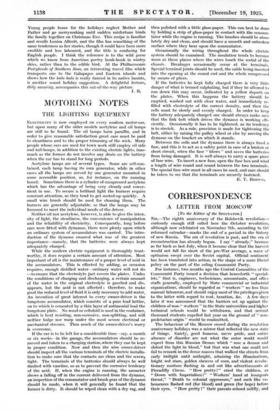MOTORING NOTES
THE LIGHTING EQUIPMENT
ELECTRICITY is now employed on every modern motor-car, but upon many of the older models acetylene and oil lamps are still to be found. The oil lamps burn paraffin, and in order to give reasonable satisfaction great care must be paid to cleanliness and to the proper trimming of the wick. Many people whose cars are used for town work still employ oil side and tail-lamps, in addition to the existing electric lights, inas- much as the former do not involve any drain on the battery when the car has to stand for long periods.
Acetylene lamps are of several types. Some are self-con- tained, each lamp having its own generator, while in other cases all the lamps are served by one generator mounted in some accessible position, as, for instance, on the running board. Sometimes there is a cylinder of compressed acetylene which has the advantage of being very cleanly and conve- nient in use. To secure a brilliant light the burners require constant attention, as they tend to get sooted-up quickly. A small wire brush should be used for cleaning them. The burners are generally adjustable, so that the lamps may be focussed to meet the individual needs of the driver.
Neither oil nor acetylene, however, is able to give the inten- sity of light, the steadiness, the convenience of manipulation and the reliability of electricity. Consequently, long before cars were fitted with dynamos, there were plenty upon which an ordinary system of accumulators was carried. The intro- duction of the dynamo ensured what was of the greatest importance—namely, that the batteries were always kept adequately charged.
While the modern electric equipment is thoroughly trust- worthy, it does require a certain amount of attention. Most important of all is the maintenance of a proper level of acid in the accumulators. This is effected by adding, as occasion requires, enough distilled water—ordinary water will not do —to ensure that the electrolyte just covers the plates. Under the conditions of charging and discharging, a certain amount of the water in the original electrolyte is gasefied and dis- appears, but the acid is not affected ; therefore, to make good the reduced level of fluid it is only necessary to add water, An invention of great interest to every owner-driver is the tungstone accumulator, which consists of a pure lead lattice, on to which is cemented by a thin layer of antimonial lead the tungstone plate. No wood or celluloid is used in the container, which is heat resisting, non-corrosive, non-splitting, and will neither bulge nor warp under the most severe electrical or mechanical stresses. Thus much of the owner-driver's worry is overcome.
If the car is to be left for a considerable time—say, a month or six weeks—in the garage, the accumulators should be re- moved and taken to a charging station, where they can be kept in proper condition. Now and then the wise owner-driver should inspect all the various terminals of the electric installa- tion to make sure that the contacts are clean and the screws tight. The terminals of the batteries should always be well daubed with vaseline, so as to prevent the corrosive tendency of the acid. If, when the engine is running, the ammeter shows a falling off in the current delivered from the dynamo, an inspection of the commutator and brush gear of the dynamo should be made, when it will generally be found that the former is dirty. It should be wiped clean with a dry rag, and then polished with a little glass-paper. This can best be done by holding a strip of glass-paper in contact with the commu- tator while the engine is running. The brushes should be abso- lutely dry and clean, and should have a smooth and unbroken surface where they bear upon the commutator.
Occasionally the wiring throughout the whole electric system should be examined. The insulation tends to become worn at those places where the wires touch the meta/ of the chassis. Brea ges occasionally occur at the terminals. Special terminal joints should be used, the cable being inserted into the opening at .the round end and the whole compressed by means of pliers.
If the batteries be kept fully charged there is very little danger of what is termed sulphating, but if they be allowed to run down this may occur, indicated by a yellow deposit on the plates. When this happens the battery should be emptied, washed out with clear water, and immediately re- filled with electrolyte of the correct density, and then the cells must be slowly and evenly charged. In order to keep the battery adequately charged one should always make sure that the link belt which drives the dynamo is working effi- ciently. Occasionally it has to be tightened, as its tendency is to stretch. As a rule, provision is made for tightening the belt, either by raising the pulley wheel or else by moving the dynamo on the bracket on which it stands.
Between the cells and the dynamo there is always fixed a fuse, and this is to act as a safety point in case of a broken or short circuit, when the fuse " blows " and saves the batteries from being damaged. It is well always to carry a. spare piece of fuse wire. To insert a new fuse, open the fuse box and wind a length of wire round and round between the two terminals. The special fuse wire must in all cases be used, and care should be taken to see that the terminals are securely fastened.
E. T. BROW N.














































 Previous page
Previous page